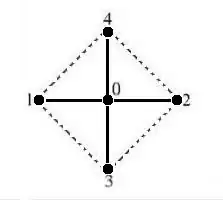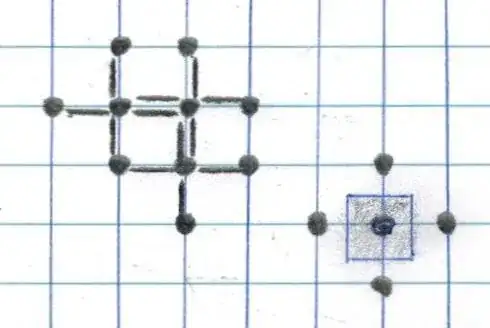An easy way is proposed by Han de Bruijn, which basically tries to find the minimum location per dimension (correct me if I am wrong). However, in that case you are not using all information you have, so it is definitely not optimal in that sense. On the other hand, I don't think there is an easy way if you want to use all data points. Below, I present the easiest way I could come up with to compute the minimum (apologies, but I find it way easier to think of a minimum instead of a maximum).
Let $y \in \mathcal{R}$ be the output of the function for which you want to find a parabolic fit and let $\bar{x} \in \mathcal{R}^d$ be the location of the optimum, i.e. where the gradient is zero. The dimension is denoted by $d$. In that case, we can approximate $y$ using our parabolic function:
$$
y = (x - \bar{x})^T A (x - \bar{x}) + c
$$
Here, $x\in\mathcal{R}^d$ denotes the input vector, $A\in\mathcal{R}^{d\times d}$ is a symmetric positive definite matrix (in case of maximization, A has to be negative definite) and $c$ is the value of $y$ at the optimum (i.e., if $x=\bar{x}$). We have $(d+1)(d+2)/2$ unknowns.
You can see that this is not straightforward to solve, as we end up with a cubic term $\bar{x}^TA\bar{x}$. For example, with least squares you can still solve this, given your datapoints $(x_1, y_1), ..., (x_N, y_N)$, with $N=3^d$. To this end, let this be the cost function you want to minimize:
$$
J(\bar{x}, A, c)=\sum_{i=1}^N \left( (x_i-\bar{x})^TA(x_i-\bar{x})+c-y_i\right)^2
$$
Through minimization of $J(\bar{x}, A, c)$, you can find the location of the optimum $\bar{x}$ and the minimum value of $y$, i.e. $c$.
I tried to write a simple function in python, which takes as input the data and the dimension $d$. I tried it for $d=4$ and it comes instantly with a solution, so I think it should also handle $d=6$ well enough. I hope it helps you.
import numpy as np
from scipy import optimize
class ParabolicInterpolation:
def __init__(self, ndim):
"""Initialize parabolic interpolation in n dimensions"""
self.n = ndim
self.datax = np.array([])
self.datay = np.array([])
self.r, self.c = np.triu_indices(self.n) # Will be used to construct the A-matrix
self.ahat = np.zeros((self.n, self.n))
def get_x_a_c(self, x):
"""Return the offset x, the A matrix and the offset c"""
xhat = x[:self.n]
self.ahat[self.r, self.c] = x[self.n:-1]
self.ahat[self.c, self.r] = x[self.n:-1]
chat = x[-1]
return xhat, self.ahat, chat
def f(self, x):
"""Return the error between model and data"""
xhat, ahat, chat = self.get_x_a_c(x)
xoff = self.datax - xhat
yhat = np.einsum('in,in->i', np.einsum('in,nj->ij', xoff, ahat), xoff) + chat # Estimated output
return yhat - self.datay
def fit(self, datax, datay):
"""Compute the unknowns using Least Squares"""
self.datax = datax
self.datay = datay
init = np.zeros(((self.n+1) * (self.n+2)) // 2)
i = -1 # Make sure we start with identity matrix
for j in range(self.n):
i += self.n + 1 - j
init[i] = 1
xopt = optimize.leastsq(self.f, init)[0]
xhat, ahat, chat = self.get_x_a_c(xopt)
print("Minimum at: [", end="")
for i in range(self.n):
print("{:.2e}{:s}".format(xhat[i], ', ' if i+1 < self.n else ''), end="")
print("]")
print("Minimum value: {:.3e}".format(chat))
return xopt
# Small demo
A = np.array([[1, 0.5, 0.25, 0.1], [0.5, 2, 0.25, -0.2], [0.25, 0.25, 1.5, -0.1], [0.1, -0.2, -0.1, 1]])
c = 0.5 # This is the minimum value we want to find
xstar = np.array([0.5, 0.25, -0.2, 0.6]) # This is the location of the minimum value
# Create some fake data
n = len(xstar)
X = np.zeros((3 ** n, n)) # Create the lattice square points
X[0, :] = -1
for ii in range(1, 3 ** n):
X[ii] = X[ii-1]
X[ii, 0] += 1
jj = 0
while X[ii, jj] == 2:
X[ii, jj] = -1
jj += 1
X[ii, jj] += 1
y = np.zeros(X.shape[0])
for ii in range(X.shape[0]):
y[ii] = np.dot(np.dot(X[ii]-xstar, A), X[ii]-xstar) + c
y += np.random.randn(X.shape[0])*0.05 # Add some noise, otherwise it is too simple ;)
# Perform the parabolic interpolation
pi = ParabolicInterpolation(n)
pi.fit(X, y)

